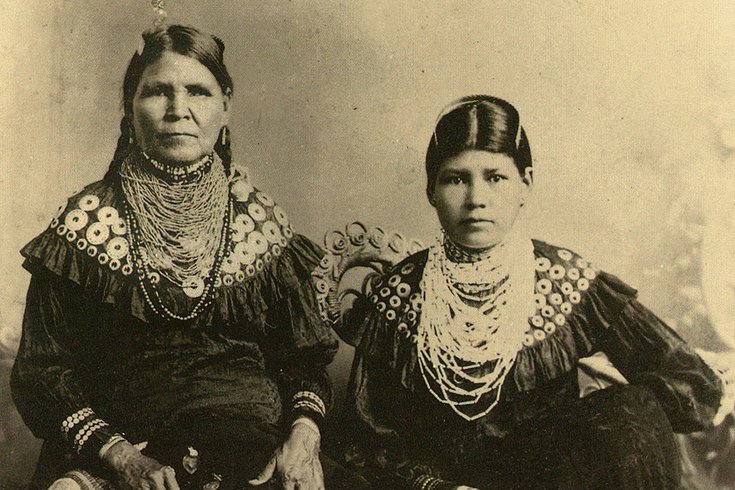
September 15, 2023
 National Anthropological Archives/Smithsonian Institution
National Anthropological Archives/Smithsonian Institution
The Lenape, also known as the Delaware people, originally inhabited eastern Pennsylvania and New Jersey. But English settlers pushed them westward to Oklahoma, where the women pictured above were photographed in 1915.
According to Indigenous folklore, Earth began on the back of a giant turtle. The creation story often begins with a woman falling from the sky, hurtling toward a watery grave. Animals spot her descent and intervene to save her life. She lands on the back of a turtle, packed with mud to form solid ground, and once she gives birth, a new world is born.
While versions of this tale appear in many different cultures, the Lenape have been telling it for at least hundreds, if not thousands, of years. Also known as the Delaware, these Indigenous Americans inhabited land on both sides of the Delaware River long before English settlers arrived.
William Penn signed a peace treaty with the Lenape one year after he established the colony of Pennsylvania in 1681, as memorialized in a painting, but subsequent colonists pushed the Lenape across the country to Oklahoma. Though many settled there permanently, Lenape influences are still felt all over the state and in the city of Philadelphia, in words derived from their language like Manayunk, Kingsessing, Passyunk and Wissahickon. Some Lenape people also remain in Pennsylvania — and are currently fighting for state recognition.
Now, their myths and traditions have been collected in a new book from Camilla Townsend, a history professor at Rutgers University, and Nicky Kay Michael, president of Bacone College and a member of the Delaware. "On the Turtle's Back: Stories the Lenape Told Their Grandchildren" traces the Lenape's folklore through stories recorded by anthropologists and the authors' own interviews and expertise. They range from fables warning against the neglect or abuse of nature to the humorous exploits of Strong Man, a literal-minded character the authors compare to Amelia Bedelia.
The Lenape's values and core beliefs shine through in these stories, and often highlight the Lenape's striking differences from Western culture, Michael says.
"If I were to actually give some concise lessons (from the folklore), a lot of it is to be a good relative," she explains. "The family and the clans and your identity are all tied together, and it all is about taking care of each other in a good way, and then also being humble. I think that's kind of an opposite trait (from) American society or the mainstream, (where) it's always self above everybody."
These principles are apparent not only in the creation myth, as animals band together to save the first woman, but in stories like "Ball Player," where five brothers all journey one by one to rescue their sister-in-law after her husband is killed. In "Snow and Ice Boy," a boy discovers he is a wintry spirit and leaves his people fresh snow to track animals.
Stories were traditionally told in the winter, after the Lenape had finished the hard work of harvesting food for the colder months. Sharing tales in busier seasons was considered not only improper but dangerous, for as Michael explains, "Things would come back on us if you didn't do it the right way." Respecting tradition kept everyone free from bad consequences like hardship and illness.
"On the Turtle's Back" also devotes a chapter to the arrival of white European settlers and how their disruption to Indigenous life appeared in folklore. A much-loved tale of the Lenape's first encounter with Dutchmen in Manhattan, New York concerns an initial sale of land "as big as a cow skin." The Lenape agree to these terms because a cowhide is fairly small, but soon the settlers begin "to cut the cow hide into a small string… that string went around a 'hell of a big piece of ground.'"
Perhaps most striking, however, is the way death plays out in these old stories. As Michael and Townsend emphasize in their book, the Lenape were not interested in tales of the afterlife because they had an accepting and peaceful attitude toward death. Binaries of heaven or hell simply didn't fit into the framework.
"We feel like the ancestors are here all the time," Michael said. "With Indigenous peoples, whether it's Lenape or any other culture that's Indigenous, you're always connected and bringing your ancestors back at certain times, and then making sure that you give offerings to them."
Due to these harmonious relationships with ancestors, you also won't find Lenape legends of spiteful spirits. A visit from beyond the grave was welcome, not an omen.
"It was really striking in the stories, how many of the women's stories were about death or ancestors, people who had died, people they had known who had died, and yet they weren't ghost stories," Townsend said. "They were ghost stories in the sense that they're about people who are dead and talking to them, but they weren't ghost stories in our sense of the word. They weren't horror stories. It wasn't macabre, it was loving.
"These were loving ghost stories."
Follow Kristin & PhillyVoice on Twitter: @kristin_hunt
| @thePhillyVoice
Like us on Facebook: PhillyVoice
Have a news tip? Let us know.